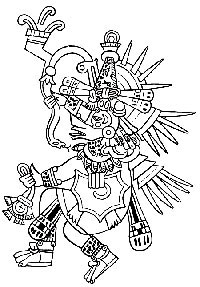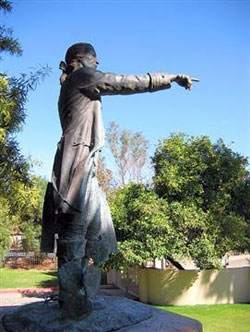|
The first
Irishman to set foot on Mexican soil may well have been St.
Brendan the Navigator, who, according to legend,
crossed the
Atlantic Ocean in his ‘currach’ (traditional Irish rowing boat) in search
of new converts to the Christian faith. An ancient manuscript
found in Medieval European monasteries allegedly described his
voyage to strange Western Lands, and is known as the
Navigatio Sancti Brendani Abbatis. Some historians claim
that Christopher Columbus found inspiration for his seafaring
adventure in the pages of the Navigatio of St. Brendan
the Abbot.
|

Quetzalcóatl |
Whether the
ancient Mexican Toltec god Quetzalcóatl (plumed serpent) was
in fact a deified Irish monk is a matter for speculation, but
the rumour seems to persist on both sides of the
Atlantic. According to the Toltec legend, a white-skinned, bearded
man from across the sea visited the shores of their land some
1500 years ago and taught the native people a new religion
based on fraternal charity and resignation to God's will. The
legend also claims that he taught them new methods of
agriculture and the use of metals, as well as the art of
developing a calendar to predict the changing seasons. To
substantiate this theory, some commentators indicate a
striking similarity between an astronomic-archaeological
centre in
Mexico and
the passage-tomb at Newgrange, County Meath in Ireland. If an
Irishman did teach the Mexicans about the art of astronomy, he
certainly did a very good job: when the Spaniards arrived,
they found the Mexican (Aztec) calendar to be more accurate
than its European (Julian) counterpart.
Irish-Hispanic historical links can also be traced, according
to historians, to the Ibero-Celts (Milesians) who, in ancient
times, set sail from the
Iberian Peninsula in search of the fabled
island of
Inis Fáil, where they established themselves as the dominant
group, and contributed to the development of the Irish
linguistic and cultural heritage. The Spanish province of
Galicia still cherishes its ancient Ibero-Celtic cultural
identity, and many Galicians regard the Irish as their distant
cousins.
Reverse
migration from Ireland to the Iberian Peninsula began on a
significant scale following the defeat of the Irish-Spanish
alliance at the Battle of Kinsale (1602), when the O'Neills
and O'Donnells, as well as other dispossessed Irish
chieftains, were given sanctuary by King Philip III of Spain.
As a result, Irish regiments were organised in the Spanish
forces, and Irish colleges were established in
Spain
to educate priests and other professionals who would minister
to the Irish Catholic diaspora in Spain and throughout Spain's
American colonies. Some were sent to the Spanish colony of New
Spain (present-day Central America) as soldiers,
administrators, explorers and missionaries, and the Hibernian
Regiment (Regimiento de Hibernia) was stationed in
present-day Mexico in the late 1700s.
The Capitán Colorado
Hugh O'Connor
(Hugo Oconór) was born in 1734 in Dublin, Ireland, and
emigrated to Spain as a young man, where he joined the
military and became an officer in the Regiment of Aragón. He
saw military service in
Cuba,
a Spanish colony, and was later transferred to
New Spain. He was appointed military governor of
Northern
Mexico by the Spanish Viceroy and was assigned the task of
reorganising and improving Spain's military outposts (presidios)
as a bulwark against the Apache and Comanche people from the
north. O'Connor earned a reputation for skill and bravery as a
military commander, and the local criollos - the
Mexican-born children of Spanish parents - referred to
him affectionately as El Capitán Colorado (the
ruddy-complexioned captain). He established new and more
efficient presidios all the way from
Texas
to California, which guaranteed a period of relative peace and
prosperity throughout the region for the settlers. O'Connor is
still remembered in
Arizona
as the founder of the original pueblo which today is
known as the City of Tucson.
|

Bronze statue of Hugo Oconór at
the Manning House, Tucson, Arizona |
Following his
arduous tour of duty in the northern desert regions, and due
to failing health, Don Hugo Oconór was transferred to the
Yucatán Peninsula where he served as governor until his death
in 1797, at the young age of 45 years.
Irish names
underwent a linguistic transformation in the Spanish-speaking
countries: O'Connor became Oconór; O'Brien, Obregón; O'Kelly,
Oquelí; O'Donohue, O'Donojú; and Murphy was transformed into
Morfi and Morfin. Just as Gaelic names became anglicised in
Ireland
under English influence, they became hispanicised under
Spanish influence. One of the most important explorers and
historians of the late 1700s was Juan Agustín Morfi, who
emigrated from
Galicia
in Spain to Mexico, where he became a Franciscan friar in
1761. He travelled extensively throughout Northern Mexico and
described life as it was lived by the indigenous people in
their pueblos. He also traced maps of some of the
uncharted regions, and provided detailed accounts of the flora
and fauna that he observed in his travels. His written account
of his discoveries as an explorer and cartographer are to be
found in his book, Viaje de Indios y diario del Nuevo
México (Mexico City: Bibliofilo Mexicanos, 1935). (Indian
Journey and Diary of New Mexico), which is still an excellent
source of information for those who are interested in the
history of the regions now known as Texas and New Mexico -
formerly the northern provinces of New Spain. Morfi also had a
distinguished career as a theologian and lecturer, and
occupied a leadership role in the affairs of the Franciscan
Order in Mexico until his death in Mexico City in 1783.
The
O'Reillys of Yucatán
Justo Sierra
O'Reilly (1814-1861) was of Irish-Hispanic lineage and became
a noted lawyer, politician, historian and novelist, who left
his mark on the history of the Yucatán Peninsula of Southern
Mexico during the early 1800s. He was legal advisor to the
state's General Assembly that rejected President Antonio López
de Santa Anna's centrist policies and declared Yucatán to be
an independent state. Santa Anna sent a military expedition to
the region in 1843 and the Assembly was obliged to sign an
agreement with the central government. When the US-Mexican war
broke out in 1846, Yucatán declared its neutrality, and US
forces occupied the Yucatán island of del Carmen.
O'Reilly was
sent as a special envoy to Washington in 1847 to negotiate the
US evacuation of the island of del Carmen and to offer the
peninsula to the United States in exchange for military
assistance to quell the Mayan uprising in the state. His
diplomatic mission was not successful, and following the
evacuation of US occupation forces from Mexico in 1848, the
Mexican government subdued the Mayans in Yucatán and restored
some semblance of order to that turbulent region. O'Reilly
became a federal congressman in 1851, and the following year
was appointed Minister for Development of his home state.
Justo Sierra O'Reilly is best remembered in Mexico for his
extraordinary contribution to jurisprudence, journalism and
literature, rather than for his polemical activities in the
political arena.
|

Justo Sierra (1848-1912) |
O'Reilly's
son, Justo Sierra Méndez (1848-1912) also became a famous
jurist, poet, author and educator, who was instrumental to
Mexican history during the late 1800s and the early 1900s. He
is known simply as Justo Sierra, whose celebrated aphorism
'the people are hungry and thirsty for justice' inspired an
ideological movement which found expression in the Mexican
Revolution of 1910. He is remembered and revered in
Mexico
for his extraordinary achievements in the field of education
and for his heroic efforts as Minister of Education and Fine
Arts to make higher education available to all, at a time when
education was mostly provided by Catholic Church institutions,
and was the prerogative of a wealthy minority. He insisted
that it was the obligation of the state to provide an
educational system that would be non-sectarian and subsidised
by the government. Justo Sierra was a strong advocate for
democracy and freedom of expression at a time when Mexico was
ruled by an authoritarian dictatorship. He is remembered
particularly as the intellectual architect of the National
University (UNAM) which now has an enrolment of some 250,000
students, and which in 1948, to commemorate the centenary of
his birth, bestowed upon him the prestigious title of
Maestro de América.
Following
the success of the Mexican Revolution of 1910, Justo Sierra
was appointed ambassador plenipotentiary to Spain, where he
died after a short illness in 1912. In 1998, to commemorate
the 150th anniversary of his birth, the National
Congress decreed that his name be inscribed in gold letters
in the Federal Chamber of Deputies. |



